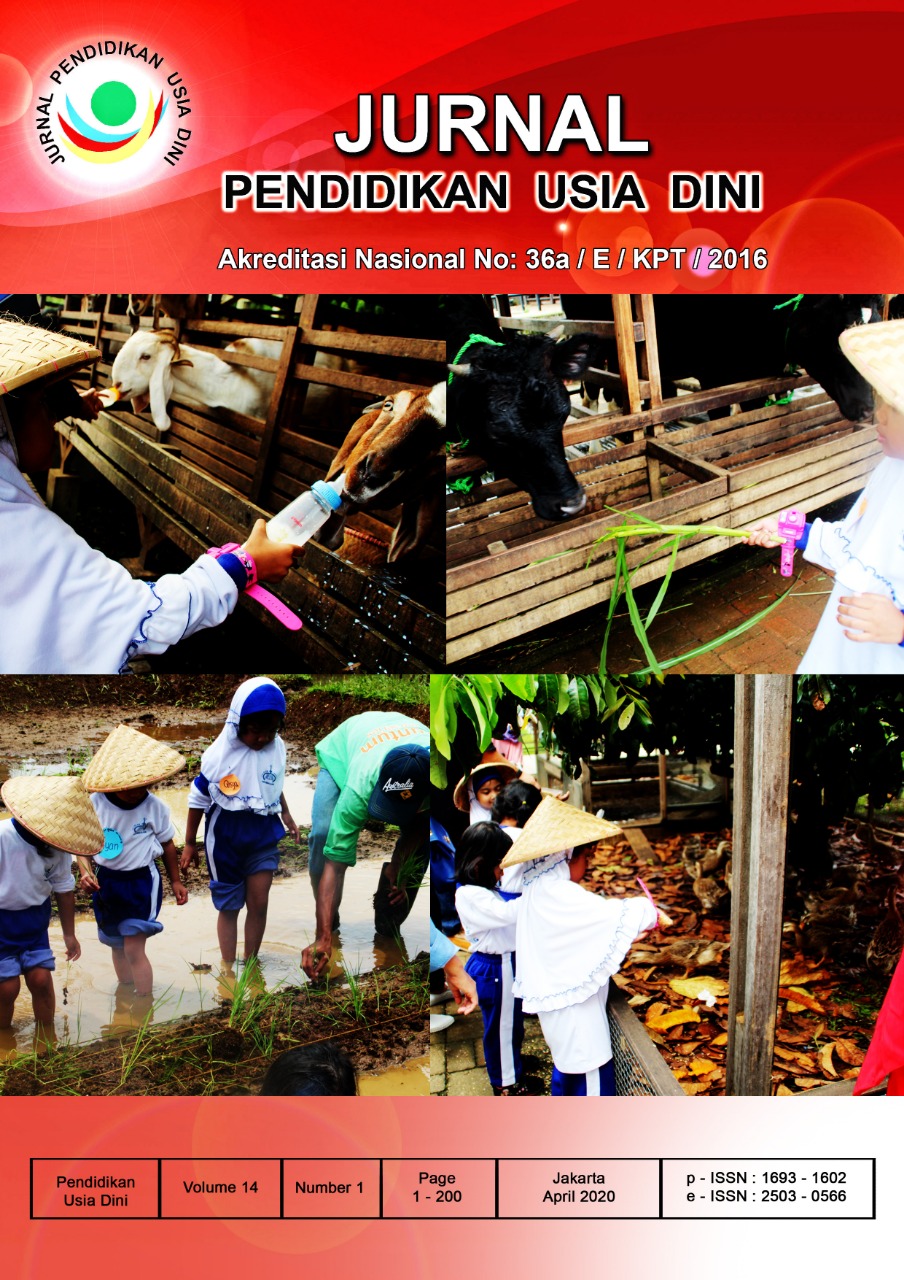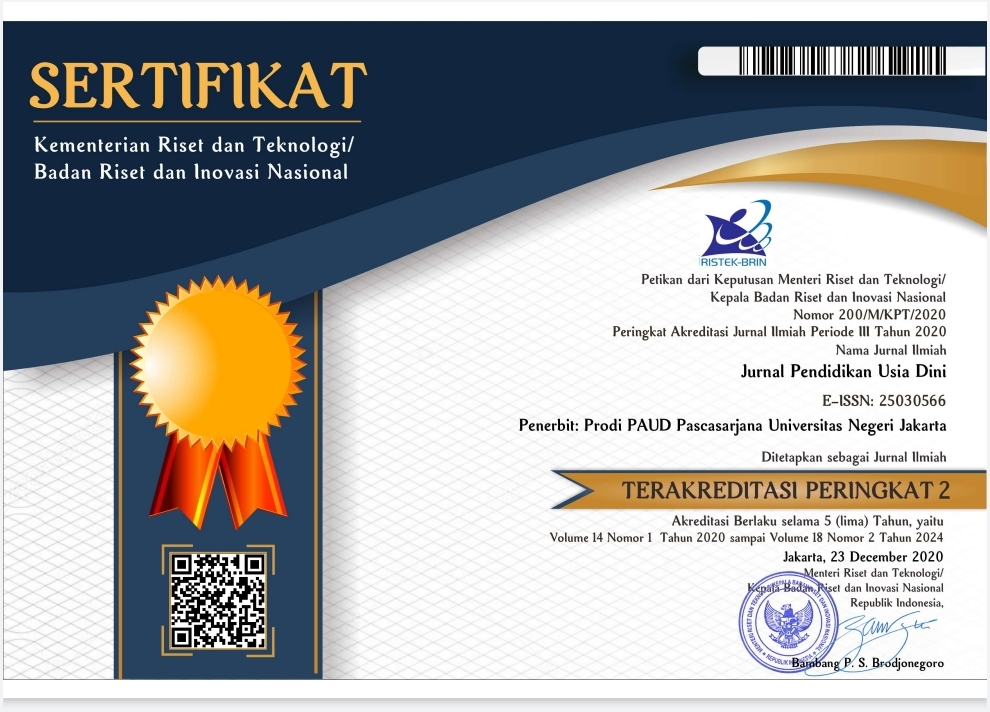The Implementation of Eating Healthy Program in Early Childhood
Abstract
Eating habits develop during the first years of a child's life, children learn what, when, and how much to eat through direct experience with food and by observing the eating habits of others. The aim of this study is to get a clear picture of the Eating program Healthy, starting from the planning, implementation, supervision, and evaluation as a case study of nutrition education; to get information about the advantages, disadvantages and effects of implementing a healthy eating program for children. This research was conducted through a case study with qualitative data analysed using Miles and Huberman techniques. Sample of children in Ananda Islāmic School Kindergarten. The results showed the Healthy Eating program could be implemented well, the diet was quite varied and could be considered a healthy and nutritious food. The visible impact is the emotion of pleasure experienced by children, children become fond of eating vegetables, and make children disciplined and responsible. Inadequate results were found due to the limitations of an adequate kitchen for cooking healthy food, such as cooking activities still carried out by the cook himself at the Foundation's house which is located not far from the school place; use of melamine and plastic cutlery for food; the spoon and fork used already uses aluminium material but still does not match its size; does not involve nutritionists.
Keywords: Early Childhood, Eating Healthy Program
References:
Bandura, A. (1977). Social learning theory. Englewood Cliffs: Prentice-Hall.
Bandura, Albert. (2004). Health promotion by social cognitive means. Health Education and Behavior, 31(2), 143–164. https://doi.org/10.1177/1090198104263660
Battjes-Fries, M. C. E., Haveman-Nies, A., Renes, R. J., Meester, H. J., & Van’T Veer, P. (2015). Effect of the Dutch school-based education programme “Taste Lessons” on behavioural determinants of taste acceptance and healthy eating: A quasi-experimental study. Public Health Nutrition, 18(12), 2231–2241. https://doi.org/10.1017/S1368980014003012
Birch, L., Savage, J. S., & Ventura, A. (2007). Influences on the Development of Children’s Eating Behaviours: From Infancy to Adolescence. Canadian Journal of Dietetic Practice and Research : A Publication of Dietitians of Canada = Revue Canadienne de La Pratique et de La Recherche En Dietetique : Une Publication Des Dietetistes Du Canada, 68(1), s1– s56. Retrieved from http://www.ncbi.nlm.nih.gov/pubmed/19430591%0Ahttp://www.pubmedcentral.nih.gov/a rticlerender.fcgi?artid=PMC2678872
Coulthard, H., Williamson, I., Palfreyman, Z., & Lyttle, S. (2018). Evaluation of a pilot sensory play intervention to increase fruit acceptance in preschool children. Appetite, 120, 609–615. https://doi.org/10.1016/j.appet.2017.10.011
Coulthard, Helen, & Sealy, A. (2017). Play with your food! Sensory play is associated with tasting of fruits and vegetables in preschool children. Appetite, 113, 84–90. https://doi.org/10.1016/j.appet.2017.02.003
Crain, W. C. (2005). Theories of development: Concepts and applications. Upper Saddle River: Pearson Prentice Hall.
Dazeley, P., Houston-Price, C., & Hill, C. (2012). Should healthy eating programmes incorporate interaction with foods in different sensory modalities? A review of the evidence. British Journal of Nutrition, 108(5), 769–777. https://doi.org/10.1017/S0007114511007343
Derscheid, L. E., Umoren, J., Kim, S. Y., Henry, B. W., & Zittel, L. L. (2010). Early childhood teachers’ and staff members’ perceptions of nutrition and physical activity practices for preschoolers. Journal of Research in Childhood Education, 24(3), 248–265. https://doi.org/10.1080/02568543.2010.487405
Eliassen, E. K. (2011). The impact of teachers and families on young children’s eating behaviors. YC Young Children, 66(2), 84–89.
Elliott, E., Isaacs, M., & Chugani, C. (2010). Promoting Self-Efficacy in Early Career Teachers: A Principal’s Guide for Differentiated Mentoring and Supervision. Florida Journal of Educational Administration & Policy, 4(1), 131–146.
Emm, S., Harris, J., Halterman, J., Chvilicek, S., & Bishop, C. (2019). Increasing Fruit and Vegetable Intake with Reservation and Off-reservation Kindergarten Students in Nevada. Journal of Agriculture, Food Systems, and Community Development, 9, 1–10. https://doi.org/10.5304/jafscd.2019.09b.014
Flynn, M. A. T. (2015). Empowering people to be healthier: Public health nutrition through the Ottawa Charter. Proceedings of the Nutrition Society, 74(3), 303–312. https://doi.org/10.1017/S002966511400161X
Franciscato, S. J., Janson, G., Machado, R., Lauris, J. R. P., de Andrade, S. M. J., & Fisberg, M. (2019). Impact of the nutrition education Program Nutriamigos® on levels of awareness on healthy eating habits in school-aged children. Journal of Human Growth and Development, 29(3), 390–402. https://doi.org/10.7322/jhgd.v29.9538
Froehlich Chow, A., & Humbert, M. L. (2014). Perceptions of early childhood educators: Factors influencing the promotion of physical activity opportunities in Canadian rural care centers. Child Indicators Research, 7(1), 57–73. https://doi.org/10.1007/s12187-013-9202-x
Graham, H., Feenstra, G., Evans, A. M., & Zidenberg-Cherr, S. (2002). Healthy Eating Habits in Children. California Agriculture, 58(4), 200–205.
Gucciardi, E., Nagel, R., Szwiega, S., Chow, B. Y. Y., Barker, C., Nezon, J., ... Butler, A. (2019). Evaluation of a Sensory-Based Food Education Program on Fruit and V egetable Consumption among Kindergarten Children. Journal of Child Nutrition & Management, 43(1).
Holley, C. E., Farrow, C., & Haycraft, E. (2017). A Systematic Review of Methods for Increasing Vegetable Consumption in Early Childhood. Current Nutrition Reports, 6(2), 157–170. https://doi.org/10.1007/s13668-017-0202-1
Hoppu, U., Prinz, M., Ojansivu, P., Laaksonen, O., & Sandell, M. A. (2015). Impact of sensory- based food education in kindergarten on willingness to eat vegetables and berries. Food and Nutrition Research, 59, 1–8. https://doi.org/10.3402/fnr.v59.28795
Jarpe-Ratner, E., Folkens, S., Sharma, S., Daro, D., & Edens, N. K. (2016). An Experiential Cooking and Nutrition Education Program Increases Cooking Self-Efficacy and Vegetable Consumption in Children in Grades 3–8. Journal of Nutrition Education and Behavior, 48(10), 697-705.e1. https://doi.org/10.1016/j.jneb.2016.07.021
Jones, A. M., & Zidenberg-Cherr, S. (2015). Exploring Nutrition Education Resources and Barriers, and Nutrition Knowledge in Teachers in California. Journal of Nutrition Education and Behavior, 47(2), 162–169. https://doi.org/10.1016/j.jneb.2014.06.011
Jung, T., Huang, J., Eagan, L., & Oldenburg, D. (2019). Influence of school-based nutrition education program on healthy eating literacy and healthy food choice among primary school children. International Journal of Health Promotion and Education, 57(2), 67–81. https://doi.org/10.1080/14635240.2018.1552177
Lwin, M. O., Malik, S., Ridwan, H., & Sum Au, C. S. (2017). Media exposure and parental mediation on fast-food consumption among children in metropolitan and suburban Indonesian. Asia Pacific Journal of Clinical Nutrition, 26(5), 899–905. https://doi.org/10.6133/apjcn.122016.04
Mc Kenna, & L, M. (2010). Policy Options to Support Healthy Eating in Schools. Canadian Journal of Public Health, 101(2), S14–S18. https://doi.org/10.1007/BF03405619
Menkes, R. PERATURAN MENTERI KESEHATAN REPUBLIK INDONESIA NOMOR 41 TAHUN 2014. , Menteri Kesehatan Republik Indonesia § (2014).
Mitsopoulou, A. V., Magriplis, E., Dimakopoulos, I., Karageorgou, D., Bakogianni, I., Micha, R., ... Zampelas, A. (2019). Association of meal and snack patterns with micronutrient intakes among Greek children and adolescents: data from the Hellenic National Nutrition and Health Survey. Journal of Human Nutrition and Dietetics, 32(4), 455–467. https://doi.org/10.1111/jhn.12639
Moffitt, A. (2019). Early Childhood Educators and the Development of Family Literacy Programs: A Qualitative Case Study. ProQuest Dissertations and Theses, 96. Retrieved from http://proxy.mul.missouri.edu/login?url=https://search.proquest.com/docview/2242479347 ?accountid=14576%0Ahttps://library.missouri.edu/findit?genre=dissertations+%26+theses &title=Early+Childhood+Educators+and+the+Development+of+Family+Literacy+Progra ms%3A+
Mustonen, S., & Tuorila, H. (2010). Sensory education decreases food neophobia score and encourages trying unfamiliar foods in 8-12-year-old children. Food Quality and Preference, 21(4), 353–360. https://doi.org/10.1016/j.foodqual.2009.09.001
Myszkowska-Ryciak, J., & Harton, A. (2019). Eating healthy, growing healthy: Outcome evaluation of the nutrition education program optimizing the nutritional value of preschool menus, Poland. Nutrients, 11(10), 1–17. https://doi.org/10.3390/nu11102438
Nekitsing, C., Hetherington, M. M., & Blundell-Birtill, P. (2018). Developing Healthy Food Preferences in Preschool Children Through Taste Exposure, Sensory Learning, and Nutrition Education. Current Obesity Reports, 7(1), 60–67. https://doi.org/10.1007/s13679- 018-0297-8
Noura, M. S. pd. (2018). Child nutrition programs in kindergarten schools implemented by the governmental sector and global nutrition consulting companies: A systematic review. Current Research in Nutrition and Food Science, 6(3), 656–663. https://doi.org/10.12944/CRNFSJ.6.3.07
Oh, S. M., Yu, Y. L., Choi, H. I., & Kim, K. W. (2012). Implementation and Evaluation of Nutrition Education Programs Focusing on Increasing Vegetables, Fruits and Dairy Foods Consumption for Preschool Children. Korean Journal of Community Nutrition, 17(5), 517. https://doi.org/10.5720/kjcn.2012.17.5.517
Osera, T., Tsutie, S., & Kobayashi, M. (2016). Using Soybean Products in School Lunch for Health Education may improve Children’s Attitude and Guardians’ Knowledge in Kindergarten. Journal of Child and Adolescent Behaviour, 04(05). https://doi.org/10.4172/2375-4494.1000310
Park, B. K., & Cho, M. S. (2016). Taste education reduces food neophobia and increases willingness to try novel foods in school children. Nutrition Research and Practice, 10(2), 221–228. https://doi.org/10.4162/nrp.2016.10.2.221
Pendidikan, K., & Kebudayaan, D. A. N. Menteri Pendidikan Dan Kebudayaan Republik Indonesia Nomor 137 Tahun 2013 Tentang Standar Nasional Pendidikan Anak Usia Dini. , (2015).
Prima, E., Yuliantina, I., Nurfadillah, Handayani, I., Riana, & Ganesa, R. eni. (2017). Layanan Kesehatan,Gizi dan Perawatan. Jakarta: Direktorat Pembinaan Pendidikan Anak Usia Dini Direktorat Jenderal Pendidikan Anak Usia Dini dan Pendidikan Masyarakat Kementerian Pendidikan dan Kebudayaan.
Resor, J., Hegde, A. V., & Stage, V. C. (2020). Pre-service early childhood educators’ perceived barriers and supports to nutrition education. Journal of Early Childhood Teacher Education, 00(00), 1–17. https://doi.org/10.1080/10901027.2020.1740841
Rizqie Aulianaca5804p200-169314. (2011). Gizi Seimbang Dan Makanan Sehat Untuk Anak Usia Dini. Journal of Nutrition and Food Research, 2(1), 1–12. Retrieved from http://staff.uny.ac.id/sites/default/files/pengabdian/rizqie-auliana-dra-mkes/gizi-seimbang- dan-makanan-sehat-untuk-anak-usia-dini.pdf
Sandell, M., Mikkelsen, B. E., Lyytikäinen, A., Ojansivu, P., Hoppu, U., Hillgrén, A., & Lagström, H. (2016). Future for food education of children. Futures, 83, 15–23. https://doi.org/10.1016/j.futures.2016.04.006
Schanzenbach, D. W., & Thorn, B. (2019). Food Support Programs and Their Impacts on Young Children. Health Affairs, (march). Retrieved from https://www.healthaffairs.org/briefs
Schmitt, S. A., Bryant, L. M., Korucu, I., Kirkham, L., Katare, B., & Benjamin, T. (2019). The effects of a nutrition education curriculum on improving young children’s fruit and vegetable preferences and nutrition and health knowledge. Public Health Nutrition, 22(1), 28–34. https://doi.org/10.1017/S1368980018002586
Sekiyama, M., Roosita, K., & Ohtsuka, R. (2012). Snack foods consumption contributes to poor nutrition of rural children in West Java, Indonesia. Asia Pacific Journal of Clinical Nutrition, 21(4), 558–567. https://doi.org/10.6133/apjcn.2012.21.4.11
Sepp, H., & Ho, K. (2016). Food as a tool for learning in everyday activities at preschool exploratory study from Sweden. Food & Nurtition Research, 1, 1–7.
Shor, R., & Friedman, A. (2009). Integration of nutrition-related components by early childhood education professionals into their individual work with children at risk. Early Child Development and Care, 179(4), 477–486. https://doi.org/10.1080/03004430701269218
Taylor, C. M., & Emmett, P. M. (2019). Picky eating in children: Causes and consequences. Proceedings of the Nutrition Society, 78(2), 161–169. https://doi.org/10.1017/S0029665118002586
Taylor, C. M., Steer, C. D., Hays, N. P., & Emmett, P. M. (2019). Growth and body composition in children who are picky eaters: a longitudinal view. European Journal of Clinical Nutrition, 73(6), 869–878. https://doi.org/10.1038/s41430-018-0250-7
Unusan, N. (2007). Effects of a food and nutrition course on the self-reported knowledge and behavior of preschool teacher candidates. Early Childhood Education Journal, 34(5), 323– 327. https://doi.org/10.1007/s10643-006-0116-9
Usfar, A. A., Iswarawanti, D. N., Davelyna, D., & Dillon, D. (2010). Food and Personal Hygiene Perceptions and Practices among Caregivers Whose Children Have Diarrhea: A Qualitative
Study of Urban Mothers in Tangerang, Indonesia. Journal of Nutrition Education and Behavior, 42(1), 33–40. https://doi.org/10.1016/j.jneb.2009.03.003
Witt, K. E., & Dunn, C. (2012). Increasing Fruit and V egetable Consumption among Preschoolers: Evaluation of Color Me Healthy. Journal of Nutrition Education and Behavior, 44(2), 107–113. https://doi.org/10.1016/j.jneb.2011.01.002
JURNAL PENDIDIKAN USIA DINI work is licensed under a Creative Commons Attribution 4.0 International License. (http://creativecommons.org/licenses/by/4.0/)




